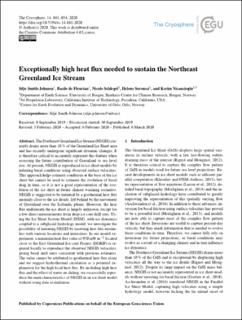| dc.contributor.author | Smith-Johnsen, Silje | |
| dc.contributor.author | de Fleurian, Basile | |
| dc.contributor.author | Schlegel, Nicole | |
| dc.contributor.author | Seroussi, Hélène | |
| dc.contributor.author | Nisancioglu, Kerim Hestnes | |
| dc.date.accessioned | 2021-03-15T11:46:16Z | |
| dc.date.available | 2021-03-15T11:46:16Z | |
| dc.date.created | 2020-08-31T15:35:33Z | |
| dc.date.issued | 2020 | |
| dc.Published | The Cryosphere. 2020, 14 841-854. | |
| dc.identifier.issn | 1994-0416 | |
| dc.identifier.uri | https://hdl.handle.net/11250/2733392 | |
| dc.description.abstract | The Northeast Greenland Ice Stream (NEGIS) currently drains more than 10 % of the Greenland Ice Sheet area and has recently undergone significant dynamic changes. It is therefore critical to accurately represent this feature when assessing the future contribution of Greenland to sea level rise. At present, NEGIS is reproduced in ice sheet models by inferring basal conditions using observed surface velocities. This approach helps estimate conditions at the base of the ice sheet but cannot be used to estimate the evolution of basal drag in time, so it is not a good representation of the evolution of the ice sheet in future climate warming scenarios. NEGIS is suggested to be initiated by a geothermal heat flux anomaly close to the ice divide, left behind by the movement of Greenland over the Icelandic plume. However, the heat flux underneath the ice sheet is largely unknown, except for a few direct measurements from deep ice core drill sites. Using the Ice Sheet System Model (ISSM), with ice dynamics coupled to a subglacial hydrology model, we investigate the possibility of initiating NEGIS by inserting heat flux anomalies with various locations and intensities. In our model experiment, a minimum heat flux value of 970 mW m−2 located close to the East Greenland Ice-core Project (EGRIP) is required locally to reproduce the observed NEGIS velocities, giving basal melt rates consistent with previous estimates. The value cannot be attributed to geothermal heat flux alone and we suggest hydrothermal circulation as a potential explanation for the high local heat flux. By including high heat flux and the effect of water on sliding, we successfully reproduce the main characteristics of NEGIS in an ice sheet model without using data assimilation. | en_US |
| dc.language.iso | eng | en_US |
| dc.publisher | Copernicus Publications | en_US |
| dc.relation.uri | ice2ice.eu | |
| dc.rights | Navngivelse 4.0 Internasjonal | * |
| dc.rights.uri | http://creativecommons.org/licenses/by/4.0/deed.no | * |
| dc.title | Exceptionally high heat flux needed to sustain the Northeast Greenland Ice Stream | en_US |
| dc.type | Journal article | en_US |
| dc.type | Peer reviewed | en_US |
| dc.description.version | publishedVersion | en_US |
| dc.rights.holder | Copyright Author(s) 2020. | en_US |
| cristin.ispublished | true | |
| cristin.fulltext | original | |
| cristin.qualitycode | 2 | |
| dc.identifier.doi | 10.5194/tc-14-841-2020 | |
| dc.identifier.cristin | 1826293 | |
| dc.source.journal | The Cryosphere | en_US |
| dc.source.40 | 14 | |
| dc.source.pagenumber | 841–854 | en_US |
| dc.relation.project | Norges forskningsråd: 288449 | en_US |
| dc.relation.project | EC/FP7/610055 | en_US |
| dc.relation.project | Notur/NorStore: NN4659K | en_US |
| dc.relation.project | Norges forskningsråd: 246929 | en_US |
| dc.identifier.citation | The Cryosphere. 2020, 14 (3), 841–854. | en_US |
| dc.source.volume | 14 | en_US |
| dc.source.issue | 3 | en_US |

